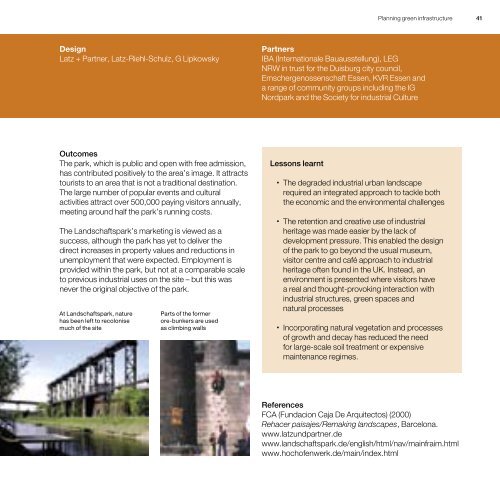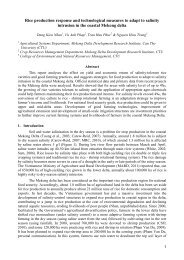start-with-the-park
You also want an ePaper? Increase the reach of your titles
YUMPU automatically turns print PDFs into web optimized ePapers that Google loves.
Planning green infrastructure<br />
41<br />
Design<br />
Latz + Partner, Latz-Riehl-Schulz, G Lipkowsky<br />
Partners<br />
IBA (Internationale Bauausstellung), LEG<br />
NRW in trust for <strong>the</strong> Duisburg city council,<br />
Emschergenossenschaft Essen, KVR Essen and<br />
a range of community groups including <strong>the</strong> IG<br />
Nord<strong>park</strong> and <strong>the</strong> Society for industrial Culture<br />
Outcomes<br />
The <strong>park</strong>, which is public and open <strong>with</strong> free admission,<br />
has contributed positively to <strong>the</strong> area’s image. It attracts<br />
tourists to an area that is not a traditional destination.<br />
The large number of popular events and cultural<br />
activities attract over 500,000 paying visitors annually,<br />
meeting around half <strong>the</strong> <strong>park</strong>’s running costs.<br />
The Landschafts<strong>park</strong>’s marketing is viewed as a<br />
success, although <strong>the</strong> <strong>park</strong> has yet to deliver <strong>the</strong><br />
direct increases in property values and reductions in<br />
unemployment that were expected. Employment is<br />
provided <strong>with</strong>in <strong>the</strong> <strong>park</strong>, but not at a comparable scale<br />
to previous industrial uses on <strong>the</strong> site – but this was<br />
never <strong>the</strong> original objective of <strong>the</strong> <strong>park</strong>.<br />
At Landschafts<strong>park</strong>, nature<br />
has been left to recolonise<br />
much of <strong>the</strong> site<br />
Parts of <strong>the</strong> former<br />
ore-bunkers are used<br />
as climbing walls<br />
Lessons learnt<br />
• The degraded industrial urban landscape<br />
required an integrated approach to tackle both<br />
<strong>the</strong> economic and <strong>the</strong> environmental challenges<br />
• The retention and creative use of industrial<br />
heritage was made easier by <strong>the</strong> lack of<br />
development pressure. This enabled <strong>the</strong> design<br />
of <strong>the</strong> <strong>park</strong> to go beyond <strong>the</strong> usual museum,<br />
visitor centre and café approach to industrial<br />
heritage often found in <strong>the</strong> UK. Instead, an<br />
environment is presented where visitors have<br />
a real and thought-provoking interaction <strong>with</strong><br />
industrial structures, green spaces and<br />
natural processes<br />
• Incorporating natural vegetation and processes<br />
of growth and decay has reduced <strong>the</strong> need<br />
for large-scale soil treatment or expensive<br />
maintenance regimes.<br />
References<br />
FCA (Fundacion Caja De Arquitectos) (2000)<br />
Rehacer paisajes/Remaking landscapes, Barcelona.<br />
www.latzundpartner.de<br />
www.landschafts<strong>park</strong>.de/english/html/nav/mainfraim.html<br />
www.hochofenwerk.de/main/index.html





